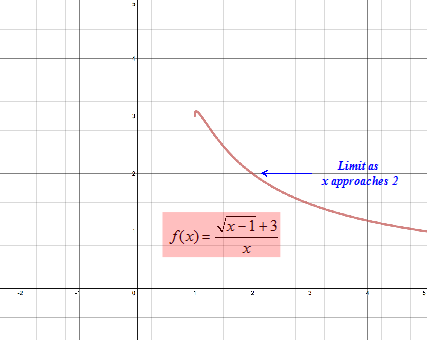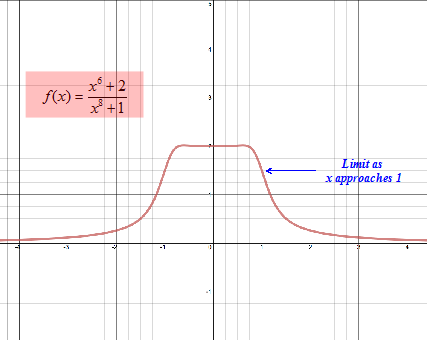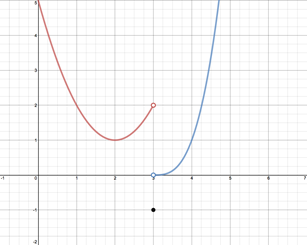Limits: Introduction and One-Sided Limits
and is read "the limit of f(x) as x approaches a equals L". So as the value of x approaches the value of a, the value of f(x) approaches L. It is important to note that the limit does not include where x = a but only the values close to and on either side of a.
Take the function as it approaches 1. The table lists the values of f(x) near x = 0.
|
x |
|
x |
|
|
-0.1 |
-1.72 |
0.0001 |
-2.0003 |
|
-0.5 |
-1.8571 |
0.001 |
-2.003003 |
|
-0.01 |
-0.1.9702 |
0.01 |
-2.030303 |
|
-0.001 |
-1.997003 |
0.05 |
-2.157895 |
|
-0.0001 |
-1.9997 |
0.1 |
-2.333333 |
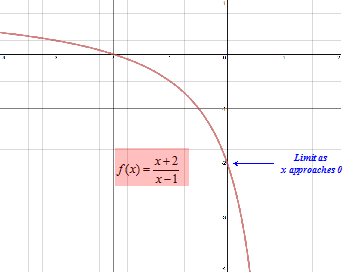
While the limit of the function seems to approach -2 as x approaches 0 from either the left or the right, some function have only one-sided limits. The following notation is used to denoted left-hand and right-hand limits.
Left-hand limitRight-hand limit
Let's take a look at some limits of the function graphed below.
The limit as x approaches 1 from the left, , is 3 while the limit as x approaches 1 from the right, , is 1. Since the left-hand and right-hand limit as x approaches 1 are different, the limit as x approaches 1 does not exist.
Now' let's look at the limits as x approaches 2. The limit as x approaches 2 from the left is 0.5, and the limit as x approaches 2 from the right is 0.5. Therefore the limit as x approaches 1 from either direction is 0.5.
Note that the when x = 2 the value of the function is 4. Thus the limit is not concerned about the value when x = 2 but only the value as x appraoches 2.
Left-hand Limit:
Right-hand Limit:
Overall Limit: = DNE
Limits as
Left-hand Limit:
Right-hand Limit:
Overall Limit: = 0.5
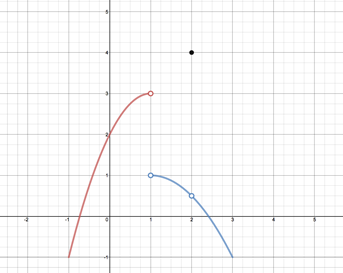
Let's find the limits in a couple examples.
|
Step 1: Graph the function.
|
|||||||||||||||||||||
|
Step 2: Create a table of values close to and on either side of 2.
The value as x approaches 2 from both the left and the right approaches 2. ; |
|||||||||||||||||||||
|
Step 3: Guesstimate the limit |
Since the limit from both the left and the right are the same, then the overall limit as x approaches 2 is 2. . |
||||||||||||||||||||
|
Step 1: Graph the function.
|
|||||||||||||||||||||
|
Step 2: Create a table for values close to and on either side of 1.
The value as x approaches 1 from both the left and the right approaches 1.5. ; |
|||||||||||||||||||||
|
Step 3: Guesstimate the limit |
Since the limit from both the left and the right are the same, then the overall limit as x approaches 1 is 1.5. . |
||||||||||||||||||||
|
Graph of Function
|
|
|
Step 1: Evaluate the limits as x approaches 3. - As x approaches 3 from the left, the value of f(x) approaches 2. - As 3 approaches 3 from the right, the value of f(x) approaches 0. - Since the value of f(x) as x approaches 3 from the left does not equal the value as x approaches 3 from the right, this limit does not exist. |
|
|
Step 2: Evaluate f(3). |
The value of y when x is 3 is -1. f(3) = -1 Notice that the limits of f(x) as from the left or right may not be related to the value when x = 1. |
|
Step 3: Evaluate the limits as x approaches 1. - As x approaches 1 from the left, the value of f(x) approaches 2. - As x approaches 1 from the right, the value of f(x) approaches 2. - Since the value of f(x) as x approaches 1 from the left equals the value as x approaches 1 from the right, this limit is also 2. |
|
|
Related Links: Math algebra Limits: Infinite Limits Limits: Limit Laws Calculus Topics |
To link to this Limits: Introduction and One-Sided Limits page, copy the following code to your site:

